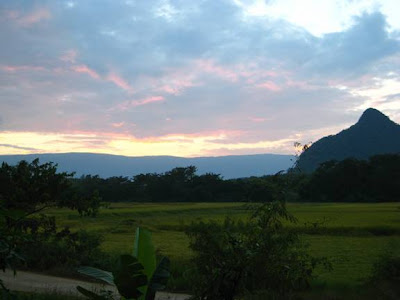We all know the phrase, “knowledge is power,” and for most of my life I have accepted the truth of this statement unequivocally. I always believed that the way to gain knowledge is through formal education; the reason I have been working to attain a degree is, essentially, to be more powerful. As we head in to the last month of our time here in Thailand, I cannot help but reflect on how my time here has altered my understanding of, and ideas about, both education and knowledge.
Our group spent a week living with families in Na Nang Bong village, which is in the North of Thailand. Villagers have been living and working there for many generations. Two open-pit gold mines have been operating for the last three years in the area surrounding the village, and in these three years the villagers have experienced dramatic changes in their health and the health of the surrounding environment. Fifty-four of 259 villagers tested positive for cyanide poisoning. Many of the fields in the area no longer produce rice, and of those that do, the rice commands a lower price at the market. The villagers were told that their water is contaminated with heavy metals and they should not drink or bathe in it. The villagers have formed a group called “People Who Conserve Their Hometown” (PWCTH) to attempt to combat the effects they have experienced and to prevent more mines from opening in the area. Through speaking with the villagers and living in their homes for the week, we learned a great deal about their lives.
We also met with representatives from the Provincial Health Office and the Ministry of Industry to discuss their role in the situation. For me, these exchanges were the most interesting ones we have had this semester. It was not what was said that was interesting, however, but rather it was the display of the power structure stacked up against the villagers and the implied judgments of what knowledge is and should be. They presented power points with slide after slide of numbers, graphs, and maps. They attempted to take us through the process of gold extraction, from prospecting to refining. The officials at each exchange reiterated numerous times that because there is no scientific proof that the mines are responsible for the effects the villagers are experiencing, the mine cannot be blamed for what the villagers are experiencing and observing. The provincial health officer stated that because the villagers only have a “fourth-grade education,” they should trust the word of the government officials who are educated and therefore much more knowledgeable.
I agree that knowledge is power, but my experience in Na Nang Bong has shown me that it is only a certain kind of knowledge that is power. Scientific knowledge is power. A B.A, DR., or PH.D after a name is power. Conversely, knowledge that cannot be translated onto a power point presentation is not power. What does it mean for a community, a country, a world where we no longer believe in the value of knowledge passed from generation to generation, knowledge that is not written in books, knowledge that cannot be plugged in to a graph or chart? What are the implications of the fact that the knowledge of the villagers, both the base on which the community has been built and the threads that hold it together, is worthless to those who possess knowledge that they paid for?
Perhaps in our relentless pursuit for knowledge, which in reality is just a pursuit for truth, we are in many ways moving away from truth. I am not saying that I want to throw two years of my college education out the window and become a farmer. On the contrary, I have only come to value my own educational opportunities more. I guess what I am saying is that I now recognize that the knowledge I am acquiring at school is merely one kind of knowledge, and I want to seek out knowledge in all its forms. Perhaps it is this other knowledge that will give me the power I am seeking: the power of appreciation, of sympathy, of connectedness, of understanding.
Haley Campbell
Bates College
Prison Bound
-
The group in our prison red
This week, our group was lucky enough to visit a prison in another town
very close to Cuernavaca. The building itself was fin...
14 years ago






